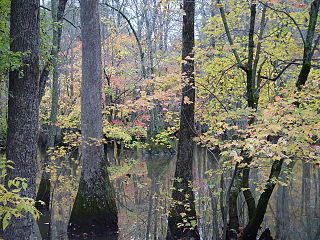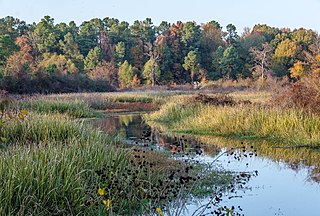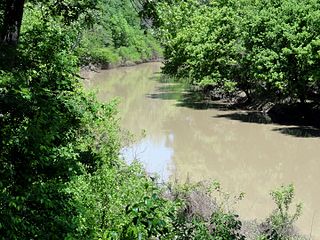
Monroe County is located in the Arkansas Delta in the U.S. state of Arkansas. The county is named for James Monroe, the fifth President of the United States. Created as Arkansas's 20th county on November 2, 1829, Monroe County is home to two incorporated town and three incorporated cities, including Clarendon, the county seat, and Brinkley, the most populous city. The county is also the site of numerous unincorporated communities and ghost towns.

Ashley County is a rural South Arkansas county with a culture, economy, and history based on timber and agriculture. Created as Arkansas's 52nd county on November 30, 1848, Ashley County has seven incorporated municipalities, including Hamburg, the county seat and Crossett, the most populous city. The county is also the site of numerous unincorporated communities and ghost towns. The county is named for Chester Ashley, a prominent lawyer in the Arkansas Territory and U.S. senator from the state from 1844 to 1848.

Arkansas County is a county located in the U.S. state of Arkansas. As of the 2010 census, the population was 19,019. Located in the Arkansas Delta, the county has two county seats, DeWitt and Stuttgart.

The Cache River National Wildlife Refuge is a 68,993 acre (223 km2) (2014) wildlife refuge in the state of Arkansas managed by the United States Fish and Wildlife Service (FWS). The refuge is one of the Ramsar wetlands of international importance under the Ramsar Convention signed in 1971. It is one of the most important wintering area for ducks and the largest remaining tract of contiguous bottomland hardwood forest on the North American continent. In 2005, a possible sighting of the ivory-billed woodpecker, thought to be extinct, brought attention to the refuge.

The White River National Wildlife Refuge is a 160,756 acres (650.56 km2) wildlife refuge located in Desha, Monroe, Phillips, and Arkansas counties in the U.S. state of Arkansas. The refuge is managed by the United States Fish and Wildlife Service. White River NWR borders on Cache River National Wildlife Refuge at its northern boundary. In 1974, the White River Sugarberry Natural Area was designated as a National Natural Landmark by the National Park Service.

Bayou Bartholomew is the longest bayou in the world, meandering approximately 364 miles (586 km) between the U.S. states of Arkansas and Louisiana. It contains over 100 aquatic species making it the second most diverse stream in North America. Known for its excellent bream, catfish, and crappie fishing, portions of the bayou are considered some of the best kept secrets of Arkansas anglers. It starts northwest of the city of Pine Bluff, Arkansas, in the Hardin community, winds through parts of Jefferson, Lincoln, Desha, Drew, Chicot, and Ashley counties in Arkansas, and Morehouse Parish, Louisiana, and eventually dumps into the Ouachita River after passing by the northernmost tip of Ouachita Parish, near Sterlington, Louisiana. The bayou serves as the primary border separating the Arkansas Delta from the Arkansas Timberlands.

Bayou Macon is a bayou in Arkansas and Louisiana. It begins in Desha County, Arkansas, and flows south, between the Boeuf River to its west and the Mississippi River to its east, before joining Joe's Bayou south of Delhi in Richland Parish, Louisiana. Bayou Macon is about 218 miles (351 km) long.

The geography of Arkansas varies widely. The state is covered by mountains, river valleys, forests, lakes, and bayous in addition to the cities of Arkansas. Hot Springs National Park features bubbling springs of hot water, formerly sought across the country for their healing properties. Crowley's Ridge is a geological anomaly rising above the surrounding lowlands of the Mississippi embayment.
Loggy Bayou is a 17.3-mile-long (27.8 km) stream in northwestern Louisiana which connects Lake Bistineau with the Red River. Bistineau is the reservoir of Dorcheat Bayou, which flows 115 miles (185 km) southward from Nevada County, Arkansas, into Webster Parish. Loggy Bayou flows through south Bossier Parish, west of Ringgold, in a southerly direction through Bienville Parish, and into Red River Parish, where north of Coushatta it joins the Red River, a tributary of the Mississippi. At East Point, LA, the river has a mean annual discharge of 1,960 cubic feet per second.
The Sherburne Complex is a joint land management venture of the U.S. Fish and Wildlife Service, the Louisiana Department of Wildlife and Fisheries (LDWF), and the U.S. Army Corps of Engineers that began in 1983. The area consists of 44,000 acres (180 km2), and is managed by the Louisiana Department of Wildlife and Fisheries. The complex is located in the Morganza Flood way system of the Atchafalaya Basin about 30 miles (48 km) west of Baton Rouge, Louisiana and actually extends a little south of the I-10 Atchafalaya Basin Bridge at Whiskey Bay, Louisiana. The bridge crosses the Whiskey Bay Pilot Channel. Located on the graveled LA 975, the west boundary is on the east side of the Atchafalaya River with the east boundary being the East Protection Levee. The complex stretches just north of old highway 190, and a short distance to the south of I-10. The nearest town is Krotz Springs to the north off US 190.

Bayou De View is an 83-mile-long (134 km) waterway that flows through parts of Poinsett, Woodruff, Monroe and Prairie counties in northeastern Arkansas. The bayou is part of the Cache and White River basins, ultimately flowing into the Mississippi River.
The Battle of Bayou Meto, also known as the Battle of Reed's Bridge, was fought near present-day Jacksonville, Arkansas, along the Bayou Meto River, on August 27, 1863. During the American Civil War, Union forces left Helena, Arkansas, to move against the Confederate-held state capital of Little Rock. Part of the Union command, under Brigadier General John W. Davidson, defeated Confederate cavalry commanded by Brigadier General John S. Marmaduke on August 25, in the Battle of Brownsville. After the action at Brownsville, the Confederates fell back to the Bayou Meto. Union attacks on August 27 succeeded in pushing Marmaduke's men back across the bayou, but were unable to break the Confederate line. Davidson withdrew back to Brownsville after the fighting. The Union advance resumed on September 6, and Little Rock surrendered on September 10, after the Battle of Bayou Fourche. Tensions exacaberated during the action at Bayou Meto contributed to the Marmaduke-Walker duel, during which a Confederate general was killed. In 2002, part of the battlefield was listed on the National Register of Historic Places as the Bayou Meto Battlefield.

The Grand Prairie Area Demonstration Project is an interbasin transfer project to provide water to eastern Arkansas for the purposes of agricultural water supply, aquifer recharge, prairie and wetland restoration, water conservation and waterfowl management. The project, conceived by the US Army Corps of Engineers' Memphis District and approved by US Congress in 1950, generally involves the pumping of water from the White River near DeValls Bluff into pipelines and canals throughout Arkansas's Grand Prairie, specifically to farmers in Arkansas, Lonoke and Prairie counties. The new water source is intended to relieve groundwater pumping from the Alluvial and Sparta aquifers that underlie the Prairie.

The Bayou Meto Battlefield is a battlefield site of the American Civil War in Jacksonville, Arkansas. It is the location of the August 27, 1863 Battle of Bayou Meto, in which Confederate forces successfully prevented Union Army forces from crossing the Bayou Meto River during their advance to capture Little Rock. The battlefield is located on both sides of the river, on either side of Arkansas Highway 161, whose bridge is the location of the 1863 Reed's Bridge. A portion of the battlefield is now preserved as Reed's Bridge Battlefield Heritage Park. The entire battlefield is the best-preserved of the three major battle sites of the Union advance on Little Rock. A 412-acre (167 ha) area covering the core of the battlefield was listed on the National Register of Historic Places in 2002.
Highway 152 is a designation for three segments of state highway in Arkansas County, Arkansas. One route of 13.3 miles (21.4 km) begins at US Highway 79 (US 79) near Humphrey and runs east to US 165. A second route of 0.7 miles (1.1 km) in DeWitt runs from US 165 east to AR 1 Business (AR 1B). A third route of 7.5 miles (12.1 km) begins at US 165 and AR 267, and the Great River Road (GRR) and runs east to Highway 17. All routes are maintained by the Arkansas State Highway and Transportation Department (AHTD).
Highway 144 is a designation for two state highways in Southeast Arkansas. One route of 7.82 miles (12.59 km) begins at Big Bayou Meto Use Area and runs east to US Highway 165 (US 165), Highway 1, and the Great River Road (GRR). A second route of 20.50 miles (32.99 km) begins at US 165 near Jerome and runs east through Lake Village to a levee near the Mississippi River. Both routes are maintained by the Arkansas Department of Transportation (ArDOT). While overlapping US 65/US 278 in Chicot County, the route is part of the Great River Road, a national scenic byway following the Mississippi River.
Highway 276 is a designation for two state highways in Arkansas County, Arkansas. One route is a short industrial access road in south Stuttgart. A second route begins at US Highway 165 (US 165) at Lodge Corner and runs 16.17 miles (26.02 km) to US 165/AR 1/AR 152 south of De Witt. A spur route, designated Highway 267S, runs south at Bayou Meto to connect to Highway 11. All three routes are maintained by the Arkansas Department of Transportation (ArDOT).
Highway 343 is a designation for three state highways in the Arkansas Grand Prairie. One route runs 4.04 miles (6.50 km) north from a county road to Highway 11. A second route begins at Highway 152 and runs 9.56 miles (15.39 km) to US Highway 63 (US 63) and US 79 west of Stuttgart. A third route begins at US 165 and runs 8.59 miles (13.82 km) north to Highway 86 near Slovak. All three routes are maintained by the Arkansas Department of Transportation (ArDOT).











